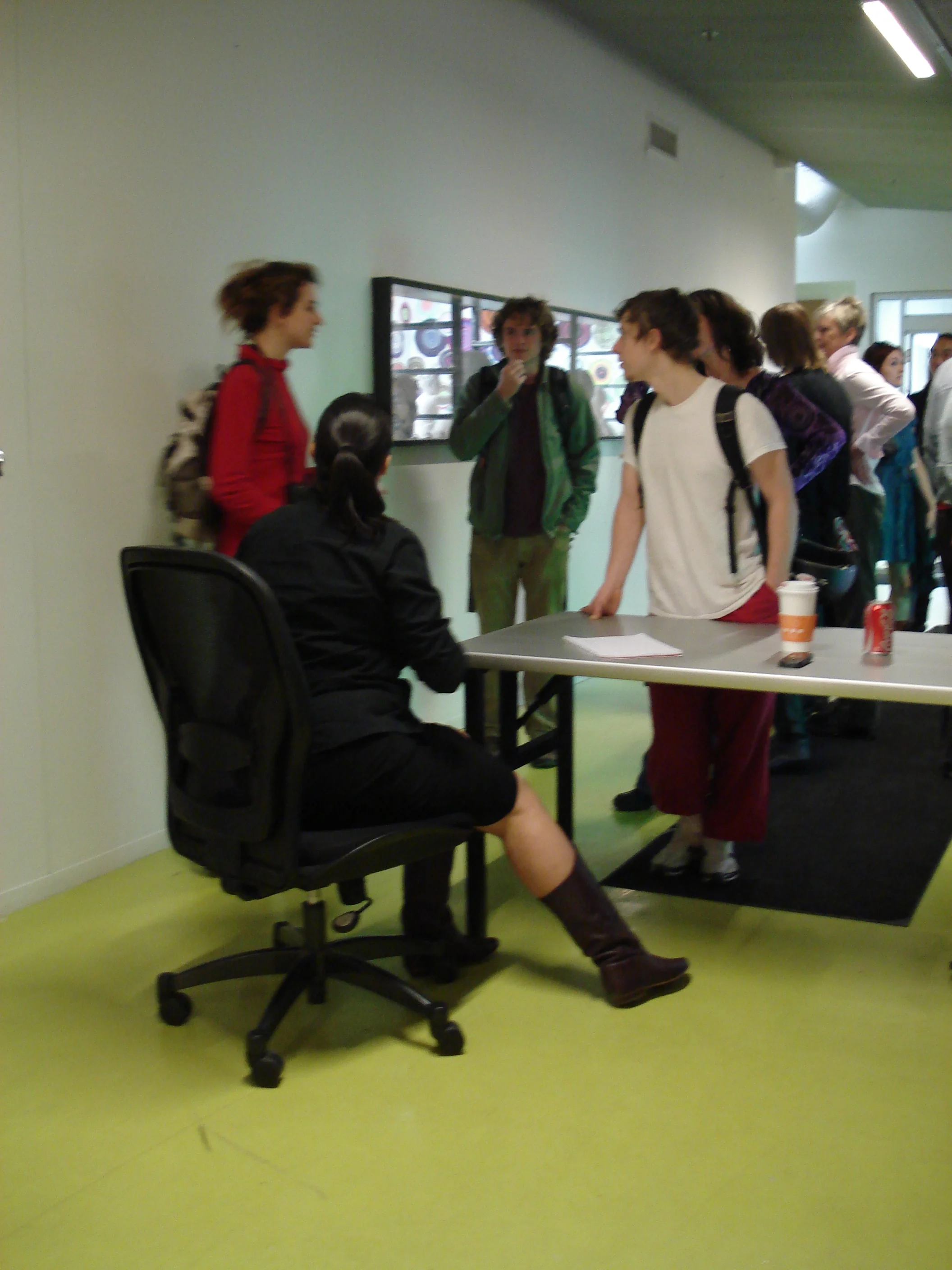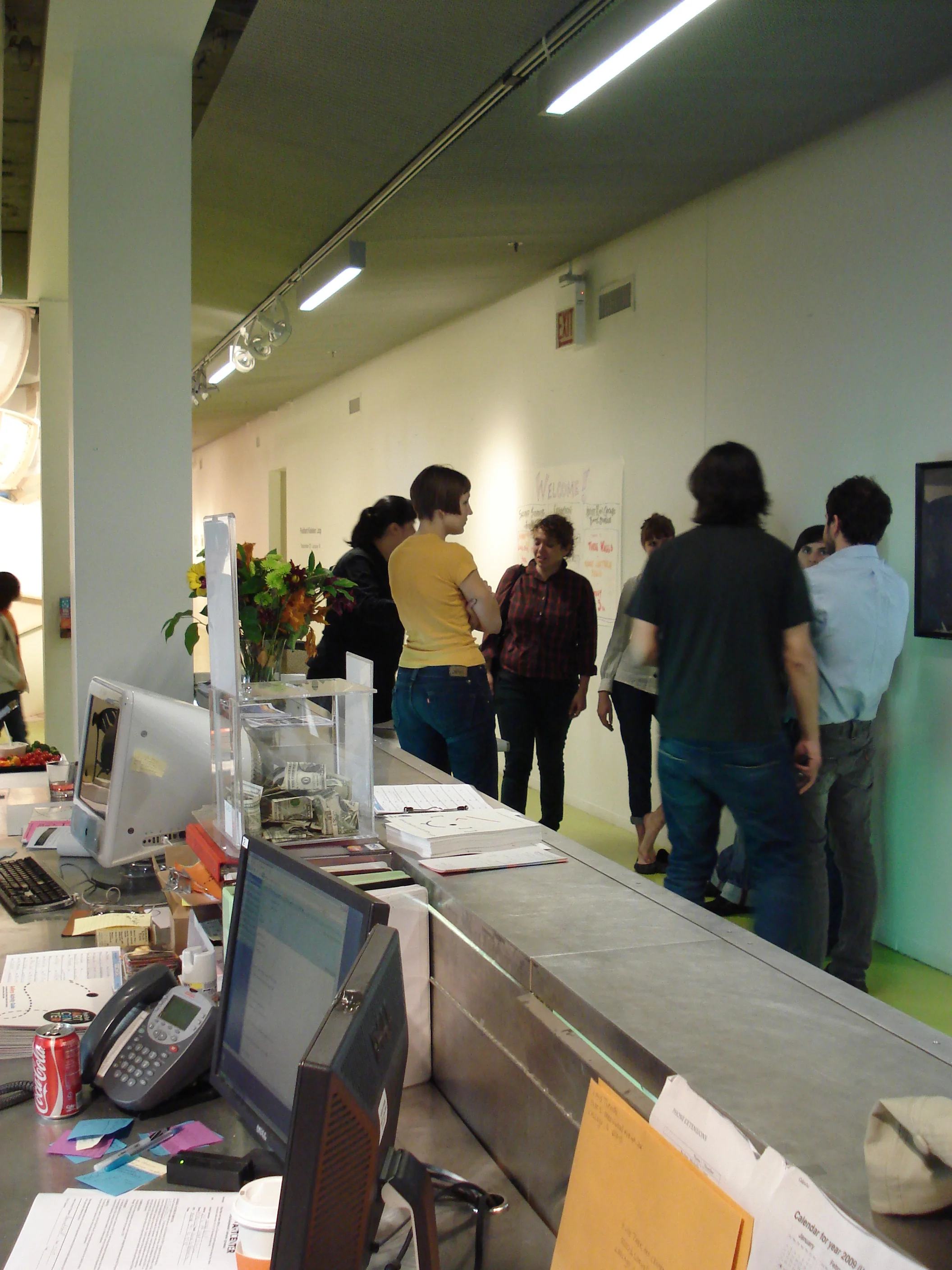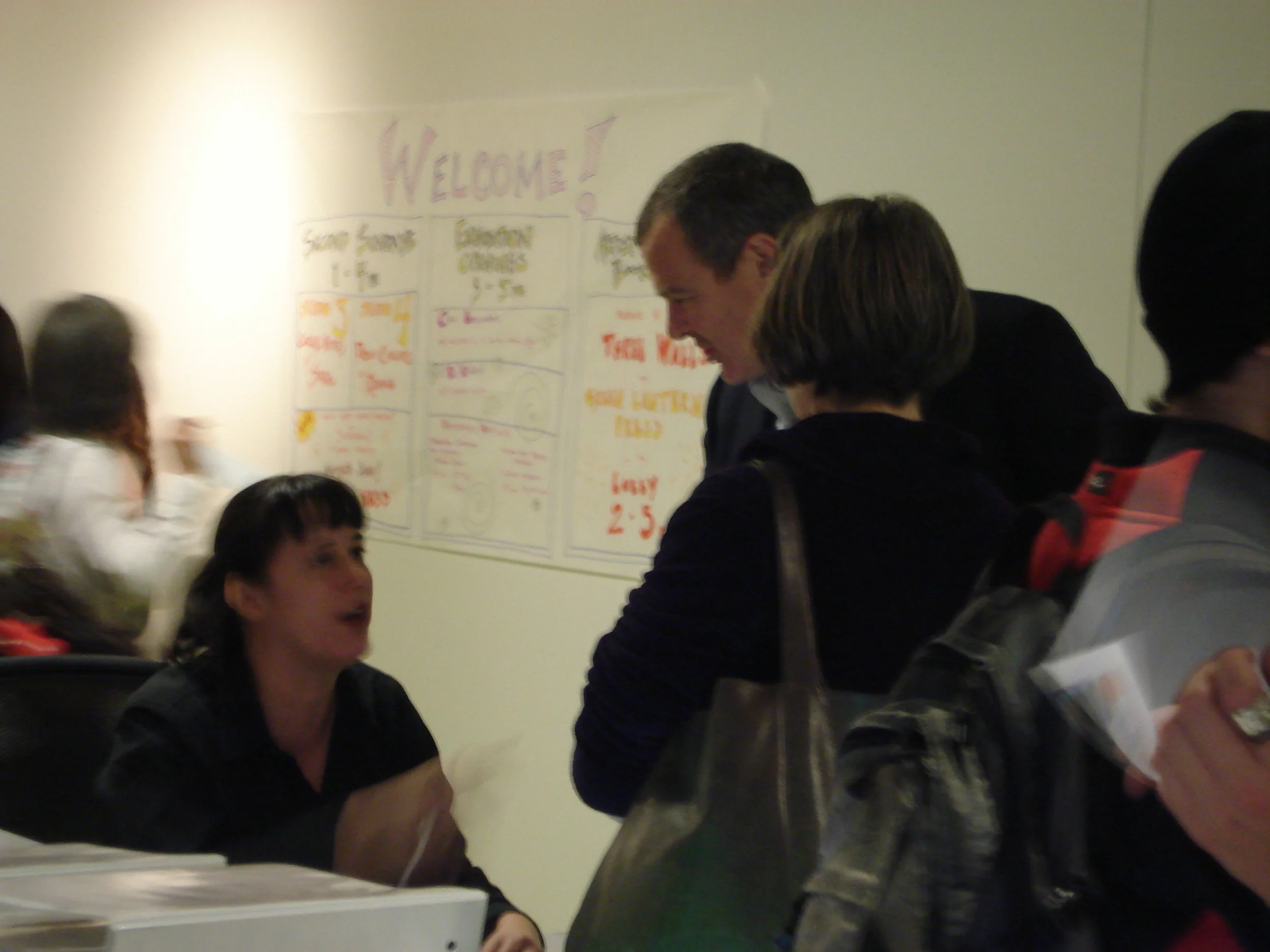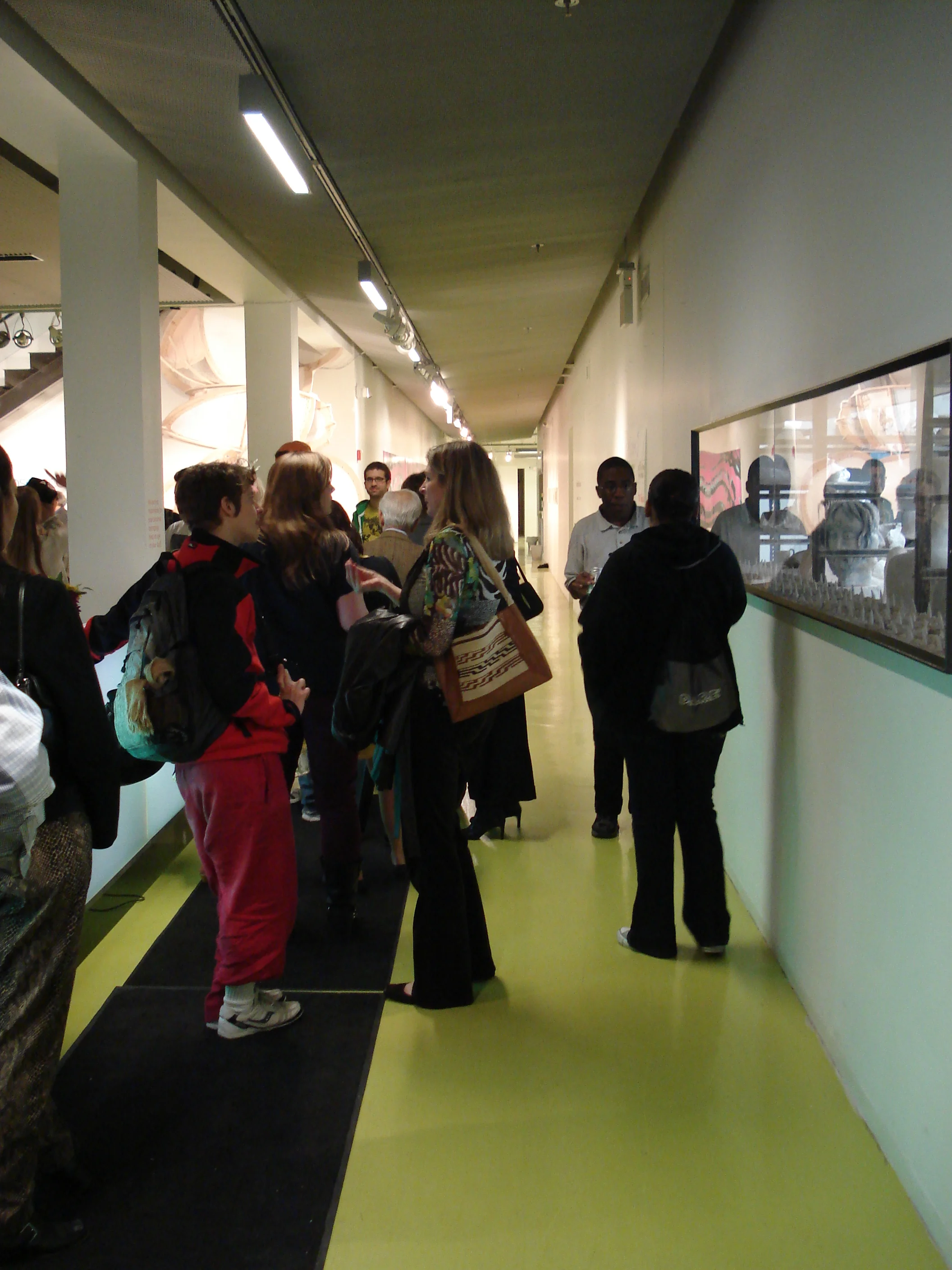Tania Bruguera: In Line for Close Encounters
An Interview with Tania Bruguera, Cecilia Vargas and Bruce E. Phillips
It was the last thing anyone expected to happen at a Hyde Park Art Center exhibition opening. For no good reason at all (or so it seemed) people were made to queue single file and subjected to stern questioning before being granted entry. Unbeknown to these faithful art lovers that their bemusement, frustration or unfazed acceptance of authority were actually art in the making. More precisely they were participants in a performance by artist Tania Bruguera which was designed to simulate how bureaucratic power interferes with societal belonging. Bruguera’s performance was of nine artists projects that have been commissioned by the Hyde Park Art Center as part of the Close Encounters exhibition November 8, 2009 - January 24, 2010.
Bruce E. Phillips: So prior to Cecilia sitting at the front desk there was the Hyde Park Art Center surveyors conducting a survey that occurs every exhibition, utilizing that desk. And then Cecilia took her place.
Cecilia Vargas: Yes it was like a natural changing of the guard between me and the surveyors. So I sat down, I had my coffee and briefcase and my notebook. I was wearing a black shirt and a long black skirt and leather boots.
BP: The desk was situated at the end of the entrance corridor adjacent to the existing front counter which architecturally guided people to form a line against the counter – in conjunction to Cecelia's orders.
CV: There was also a strip of black carpet that I used as a visible marker to order people into a single file line by asking in an authoritative tone 'can you please stay on the black carpet'. I am not a performer but I have a background in teaching art classes so rather than performing, it was like ordering teenagers around. And talking with you [Tania] prior to the performance, we discussed how people interpret instructions. I had to act in a authoritative way that was true to my personality, so that all I had to do was ask the questions that I have been commissioned to ask. Since your work is often about power relationships I assumed an authoritative position over people. Also, as we discussed, to pay attention to peoples energy and when people started naturally getting in line that was a very strange thing – I tried to act appropriately within the framework you gave me.
I mostly tried to improvise and sometimes people would direct questions to me and ask why I was asking these questions and I just responded in a very vague way saying 'well you know the institution and bureaucrats are always gathering information'. People accepted that as an answer. I guess that people often relinquish their personal information to participate in society. So I would say to each person, 'I would like to ask you a few questions' I asked their name, age, occupation, why did they want to visit the exhibition and what did they think they were going to learn about New Zealand or what is New Zealand art. I had a variety of answers. Some people would respond, 'I don't have any expectations' and I would say 'what do you mean? That you come into situations and don't have any expectations?' I was surprised because most of these people were part of the art scene and they had no conscious realization as to why they were attending this exhibition opening.
Tania Bruguera: What was the moment when people could go in?
CV: I allowed people to go through after I asked them the expectation question. Some people tried to bypass the line and walk in but I would stop them and ask them to get to the back of the line. I would also instruct them by explaining what I needed 'I need you to get in single file please'. One person asked if they could go to the bathroom but I asked 'can you come back' I only said 'can you' and that was enough to make her feel like she had to return to the line and she did.
TB: Did you hear about anything going on on the other side of the line? Because there were also the other two performers within the line that even you were not aware of. I gave them other instructions. I wanted them to question the function of the exhibition as a tool or format for knowing other cultures and for learning. So I asked them to talk with people in the queue and guide a discussion onto those topics.
CV: I was aware that there were other performers but I didn't know what their role was.
TB: It was important to me that while some people might realize that the person on the front desk was a performer that they had no idea that the undercover performers in the line were not. So for me the function of your role on the front desk was not to be the performance but to establish the situation for the undercover agents to initiate conversation.
BP: How did you respond to the people that were upset or frustrated?
CV: Some people got angry and said things like 'can you just hurry up, I just want to go to the opening!'. In one instance a man wouldn't answer the question but out of pride and to gain a bit of the power he demanded 'next question!' in some strange attempt to reverse the power and answer them on his terms.
TB: It was also important to me that all of the performers had very little acting experience. I do not like working with professional actors because since they work with audiences they tend to be predictable and give away the fact that it is a performance. And I think in this instance a professional actor would have acted up and would have denied this person their own choice to experience the work on their terms.
CV: There was also a woman who I recognized as a curator and she just bypassed the line and strutted in. And then some people who knew the building I think realized that they could enter a different entrance and get around the line.
BP: Yes it was also interesting to see how the line would naturally form, dissipate and then form again. The prescience of the line was like a living and constantly changing object. The other interesting aspect was how it worked contrary to the philosophy and architecture of the Hyde Park Art Center. Being a contemporary art center that functions as a hub for the local community it was a great surprise to many that they would have to wait and be interrogated. The Center is also a open and welcoming institution architecturally speaking since it has many entries into the building rather than just one. As you say Cecelia people who are familiar with the Center or perhaps who are smart and cunning enough could exercise their free will to find a way to get around the line while others by default chose to be complaint.
CV: Tania I think your work is very multilayered and difficult to document even through video. It could be said that your work frames life, I mean it doesn't take it out of life or return it to life it just frames it. But there is always the question as to where the work starts and ends. I think that this ambiguity is important to your work.
TB: Yes but it is also important to me that a performance is not obviously art. I really like the fact that the conditions of an 'art experience' are not always present. I really like this idea that art is not something permanent: neither the experience or the object. So I like the fact that you can think that it is art now, but moments from now it's not art. I really like this slippage of what is and is not considered art.
CV: The ambiguity of your practice made it difficult to me, as a performer in your work, to know what I should be doing. It was difficult to know how to act in every given moment.
TB: Yes, I think there is a problem with the medium of performance art, especially with the use of documentation because it is too clear that it is art, I like when things are not clear. This performance is rich in that respect. I like the way my practice is generating photos now as opposed to my previous work. For instance, if you look at the photos of my performance where I was eating dirt, the pose is very iconic and beautiful. Whereas, with the photos I am encouraging now (and I am doing this totally on purpose) resemble snapshots or lay photography. Because documentation, even video documentation, can put you in this state of 'is this supposed to be art ?'. I like how this effect is not as restrictive.
CV: So where does that leave you, since there is a long legacy of performance existing as documentation or documentation as art?
TB: First of all, I am removing my control from how a performance is documented, which is a very big risk. Previously, I edited the video footage so that it was a polished document. Now I no longer edit my videos because I am wary of trying to adopt the language of cinema to represent a performance. I am also getting rid of my control to allow others the authority to not only document how they like, but also to sell it and to get profit out of it for themselves. This is an idea that I am very proud of because if I am getting profit out of it and the others are the ones making the work exist, why can they not have profit out of the experience?
CV: How does that philosophy relate to the profession of the paparazzi?
TB: The first thing to remember that this is an approach that I will review in about five years which is how I work. I think paparazzi is not a good relationship for this type of work for a few reasons. I would hope that people are selling their experience and not the sensationalizing that occurs in news media. Otherwise the focus of the story will reflect the 'I was there, I have the scoop, I can reveal all' mentality. Because for me the problem with performance is that it can always become an icon, you can always become a figure, you can always become an image and I am against that. I mean I want it to become an image but rather an image in your head. So I think if people sell their experience it will be a more interesting type of documentation than me controlling the representation.
CV: I understand that you are also interested in creating rumor as a form of documentation that can grow to the point of mythology, where it is hard to understand the truth of what actually has occurred in your performances.
TB: For me rumor is the best form of docume ntation because I want people to have the experience in their head. I like the fact that people will say to me, I still remember the piece in Documenta11 [Untitled (Havana), 2000] – for me that is an indication that the work was successful. When people still remember three or four years after, for me that's what I consider the documentation. Control over documentation is the problem of performance. I think artists want to have all the permanent benefits of doing a sculpture or painting and I believe that approach is totally wrong. If you are doing performance you know that you cannot achieve that level of stasis. So my approach is to deal with the fact that performance is intangible and to find another way for the performance to survive.
BP: Could it also be said that performance art doesn't have a tangible context once it is out of the frame of the theater even though it might occur in the gallery context? I think this is a strong aspect of the performance that occurred at the opening. There was quite an element of surprise and it occurred in such a way that people were not aware of it being a performance - despite the fact that it was occurring in an art gallery. The performance intervened surreptitiously into the social convention of an exhibition opening - thereby taking people by surprise. So it occurred to me that perhaps it is best to describe this type of work as a social experiment rather than a performance.
TB: Yes I am more and more thinking that my work is a social experiment. However, where I come from in Cuba it is very hard to intervene and disturb social conventions like this without getting in trouble with the authorities. But if you call it art, you can do whatever you want. So maybe by natural instinct I am insisting that what I do is art. But I agree with you, I do believe that it is a social experiment. For example I love Artur Zmijewski's work because he also works with behavior. I think that the difference between our work is that he stages behaviorism in a very confined way which is clear that it is a social experiment. In my work, however, it is hopefully frameless, just happening and hard to know if it is a real occurrence or an artistic experiment.
CV: Tania I remember you mentioning in an essay that you try to create useful art and art that attempts to solve problems. Could you explain this?
TB: I think the usefulness of art is something I don't use in every work because I am a very busy artist and I have so many ideas I act on things when I can. Not every idea aligns to that philosophy or is appropriate to function in that way. I have two types of work: a short term project and a long term project. This performance is indicative of a short term work where I am trying something out for the first time This type of work often tends to be easy to class as art and it has a very defined beginning and end. The long term projects on the other hand are more social. I try to get inside the social tissue over a period of time and I try to actually alter that tissue and try to propose a different way of doing things. Now that is a useful outcome. This idea that art is not just a representation but it can be the presentation of another way to think. It doesn't just only function as a proposal, because a lot of artists only propose, I like to say lets do it and show it that way, so people can experience it and then decide on their own and debate with others. This first-hand experience is important, because often the goals or vision of my long-term projects appear to be impossible to realize, but I actually find a way for them to happen. In that way it presents an example to inspire others to take on board the possibility of such change. Not that I give the impression of change being easy, but that it reveals that it is possible. People might wonder, that given the right money and infrastructure 'I can also try this'. So I want to try and inspire this wanting to feel as though difficult change is possible, even if people don't agree with my ideas. I want people to feel empowered. The idea of usefulness comes from my background in socialist countries. In Cuba, art has to be useful whether it is for an educational or political purpose, or if it is incorporated into other aspects of life.
CV: So to what extent does this performance exercise this type of usefulness?
TB: Since it is a short-term work, it acts as an experiment. Now that I am establishing a political party in Paris as my next long term work, I will be using some of the elements that this work had, for example, how to control the audience, but I will use these techniques in a more consolidated way I treat these short works as learning platforms. You never know how people will react and performers can never have a studio to try out work. Instead, performers have to test it out in real life with real people. That is a huge risk, because you have to intervene into a particular situation. This piece would be very different if I tried it in a different location.
CV: How about the idea of utopia? Does this filter into your notions of Useful Art?
TB: Yes I think so, because I don't see utopia as an impossible goal. I don't see it as some dream place that doesn't exist only to be imagined in an echo of your reality. I really believe utopia is the first step to reality. This is a socialist point of view because in socialism we believe that we are living the utopia in everyday life even though that is not true. We are under the influence that utopia is a practice. And perhaps once it is practiced it is not utopia anymore.
There are particular ways that my work has been directly useful, for example, the art school I established and the political party in Paris that I am currently establishing. There have also been some other works that have inadvertently become useful, like my performance at the 2009 Havana Biennial that has inspired other artists to stage similar protests. I had no idea that this work would inspire such intensity and it just proves that performance is energy that can be reciprocated. Especially since people in Cuba are generally meek, because there are very serious consequences if you speak out about something. However, in this instance people felt really safe. This is my job as an artist in these instances. In these works I established an environment so that people can take over the power and overcome the power structure. In this piece I was not interested in this concept because here in Chicago it is a different situation. So I wanted to enact a power structure because I was more interested in the discussion that would be created among people waiting in the line and for that we needed to have control of the crowd.
BP: But people could chose to be controlled or not.
TB: Of course yes. I think it's good to give people options. I don't like the idea that at a performance your free will should be violated.
BP: So what do you think about upsetting people then? Or the fact that people felt that they were exploited or tricked into participating and that their emotional response will be their lived experience of the work. Is that not contrary to your aspirations of empowerment?
TB: Well I think that like how a sculptor uses traditional techniques to manipulate space and material, I work with behavior as tools. This is something that I believe, especially with reactions like shock, discomfort or unpleasant experiences. These reactions are not the goal of the work, rather they are my mechanisms to produce the work. So I think if somebody is displeased that's good, because it means that in order for the work to have significance for him he had to go through those emotions. I do not believe in pleasing the audience. I think that is a problem that a lot of artists have - including myself sometimes. I do not intentionally go out to displease people with a punk-like attitude. I don't work like that. I start with a goal and if the experience that needs to be engaged is not pleasing then that's something new that you will not have in your house or your job. Society is trying so hard to make people feel good that in the process they are forgetting what society should be about. That's something I want to do in my work: I want to think about what society should be about. I think society should be about freedom, but not in the sense that it is used here in the United States where freedom is used in a very antidemocratic contradictory way. Rather I want people to be thinking actively. Society should be about a group of people getting together to do something, and part of coming together is to think. The problem is that people are not thinking, they are just doing and they let someone else think for them I like the idea that people could have more control of the overall project. Even in a country like the United States, where it is considered more open and free, there is still really an impenetrable hierarchy. Through my work, I like to create the possibility where people have the option to be in power or in charge. You don't have to be in power for very long. Power should be temporary – you might be able to attain power but you shouldn't own it.
BP: So in some respects you set up an incubator for experience that is also part of the real world at the same time.
TB: Yes hopefully because to be within an art situation is not being in the real world. I hope to not be so safe myself and to do work outside the art institution. I always say I want to do hyper-realistic work in the sense that it is a parallel reality and works as reality. I also like to situate the work in the art world because I want to bring the discussion to multiple levels because I also want to discuss what art is for and what should we do with these types of powerful tools. So I always like to talk about the social, the political, behavior and also be aware that it is art. I want people in the art-world to realize that we have this freedom and not to take it for granted. I also want to challenge the notion that art only exists in certain contexts, but rather to prove that it can also spill out into other contexts. I try to be in the middle of these two discussions between the political, social and the artistic. Hopefully in the middle, peoplecan discuss things from both sides with a shared intensity and ownership of the experience. I like that this performance was not very defined I am trying to make the borders of my work very blurred.









